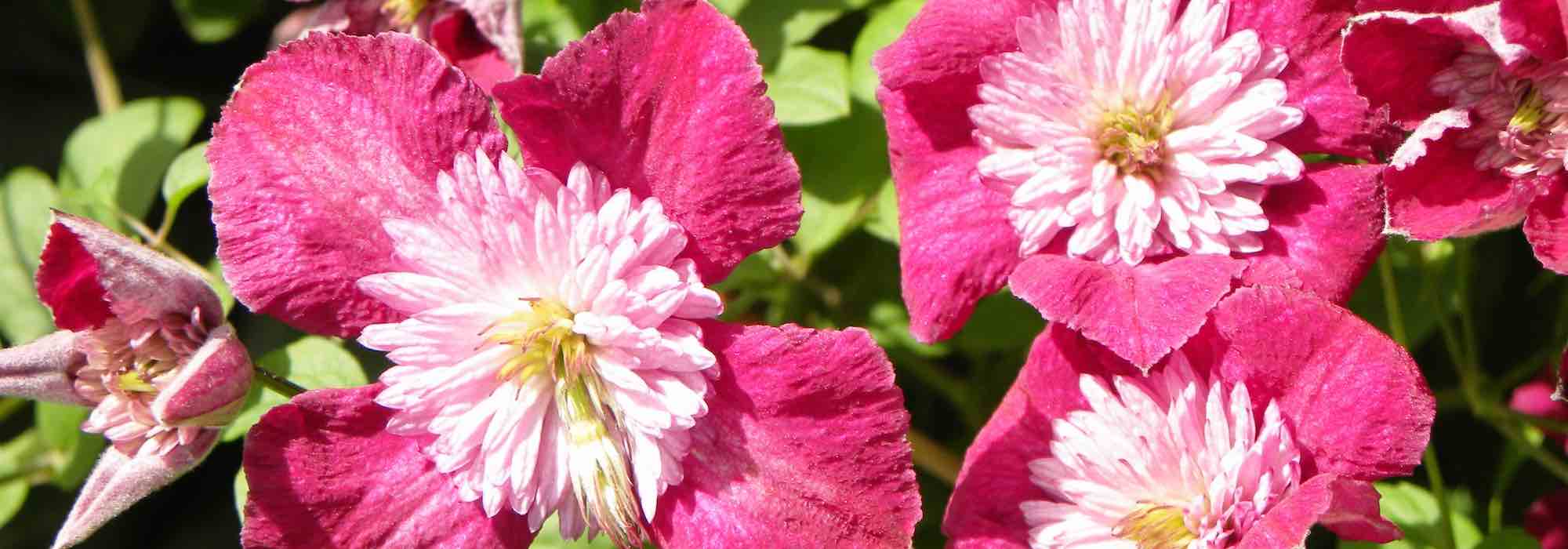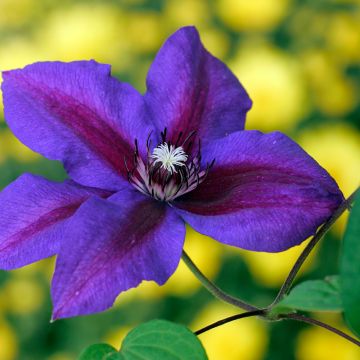

Clematis lanuginosa Lawsoniana


Clematis lanuginosa Lawsoniana
View more pictures
Hide images
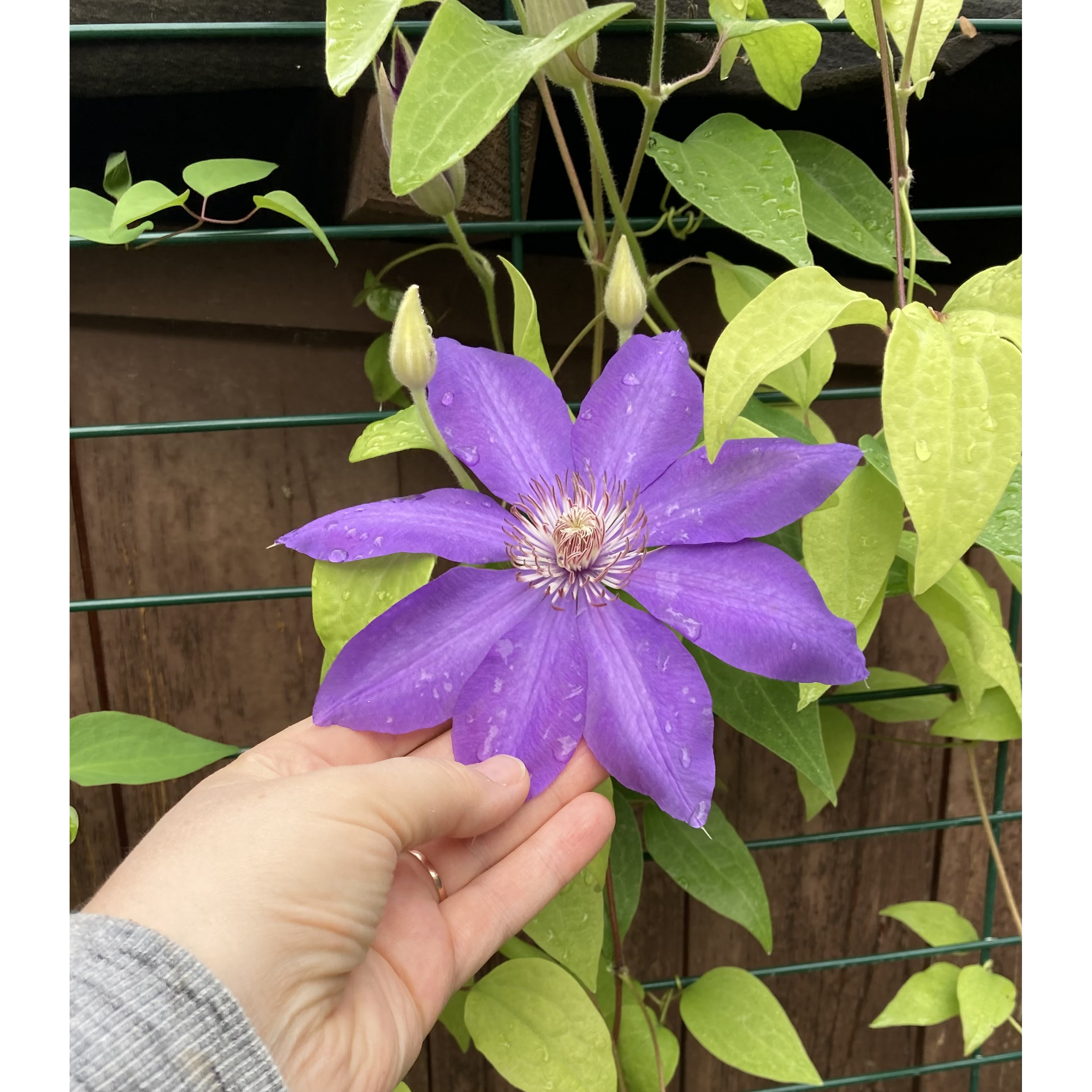
Natalia L.

This is not a text to be translated.
Natalia L. • 77 FR
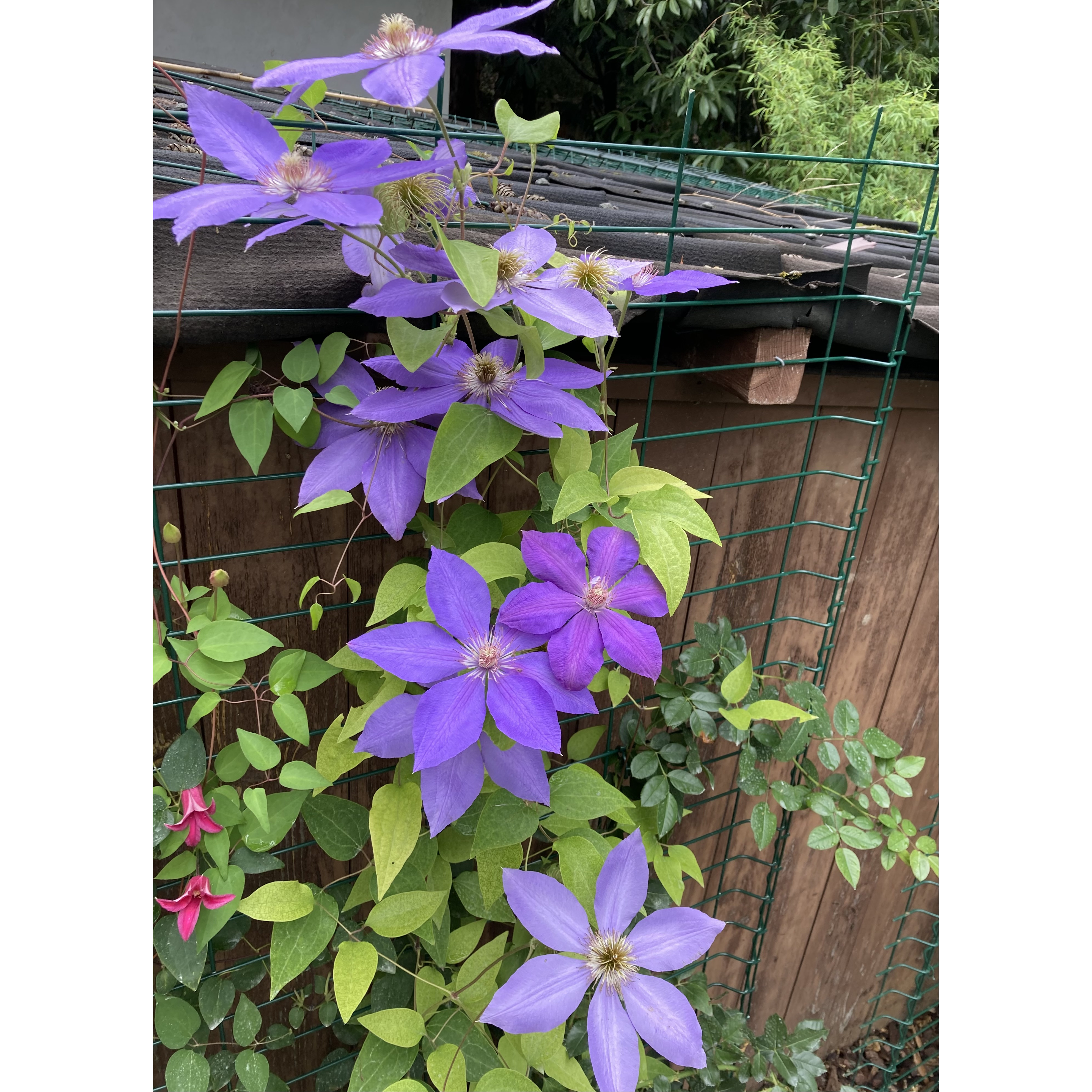
Natalia L.

First year flowering
Natalia L. • 77 FR
Clematis lanuginosa Lawsoniana
Clematis x lanuginosa Lawsoniana
Young plant in good condition relating to root, but 2 very small branches pruned to 50cm (20in) for packaging, it looks a bit thin.. Let's keep our fingers crossed.
FP51, 05/08/2023
Special offer!
Receive a €20 voucher for any order over €90 (excluding delivery costs, credit notes, and plastic-free options)!
1- Add your favorite plants to your cart.
2- Once you have reached €90, confirm your order (you can even choose the delivery date!).
3- As soon as your order is shipped, you will receive an email containing your voucher code, valid for 3 months (90 days).
Your voucher is unique and can only be used once, for any order with a minimum value of €20, excluding delivery costs.
Can be combined with other current offers, non-divisible and non-refundable.
Home or relay delivery (depending on size and destination)
Schedule delivery date,
and select date in basket
This plant carries a 6 months recovery warranty
More information
We guarantee the quality of our plants for a full growing cycle, and will replace at our expense any plant that fails to recover under normal climatic and planting conditions.
Would this plant suit my garden?
Set up your Plantfit profile →
Description
The Lawson's Clematis is one of the few hybrid varieties that produce such large summer flowers. When it thrives, its simple but immense corollas in a lovely mauve-lilac colour bloom abundantly, in successive waves, for over two months, often exceeding 25 cm (9.8 in) in diameter. If not pruned, this variety can grow up to the top of a small bush. To fully enjoy its magnificent flowering, you can also let it run along the ground, between bushes.
Clematis belongs to the family of Ranunculaceae. The 'Lawsoniana' variety, selected in Scotland in 1870, is the result of a cross-breeding between the Clematis lanuginosa and C. 'Fortunei'. Vigorous and floriferous, its only weakness is its susceptibility to wilt under poor growing conditions. It is a perfectly perennial, semi-woody and climbing plant, which can reach approximately 3.50 m (11 ft 6 in) in height, with a minimum spread of 1 m. This clematis bears very large star-shaped flowers, reaching up to 25 cm (9.8 in) in diameter, or even more. They appear in June on last year's shoots, and then again on new shoots in successive waves until the end of August. The flowers are solitary or grouped in cymes. They have 8 wide tepals with undulated or slightly folded edges, in a fairly bright blue-lilac colour, with a slightly lighter median zone. The centre of the flower is adorned with a beautiful crown of pale yellow stamens forming a small pompom. The flowering is followed by decorative feathery silver-grey fruits that remain until winter. The glabrous leaves are opposite, oval in shape and a beautiful light green colour. This clematis clings to the support or host plant through petioles transformed into tendrils.
Plant your clematis alongside your climbing roses to extend the flowering season of your walls and pergolas until the end of summer. The Lawsoniana variety pairs well with dark foliage, such as that of the Prunus pissardii or the large flowers of the Nelly Moser variety. It is a genus rich in diversity, with flowers of all colours, shapes, and sizes. Take advantage of their easy cultivation to give your garden a romantic and bohemian touch.
Tips: Avoid excessive use of fertiliser as it stimulates foliage growth at the expense of flowers. Do not mulch to avoid excessive moisture which can encourage wilt.
Clematis lanuginosa Lawsoniana in pictures
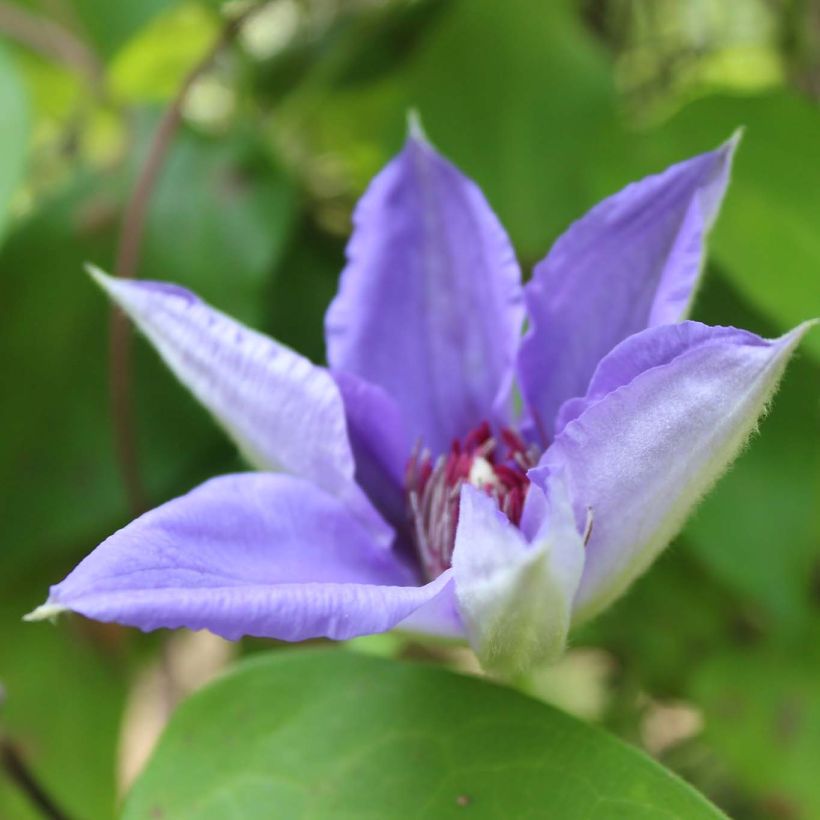

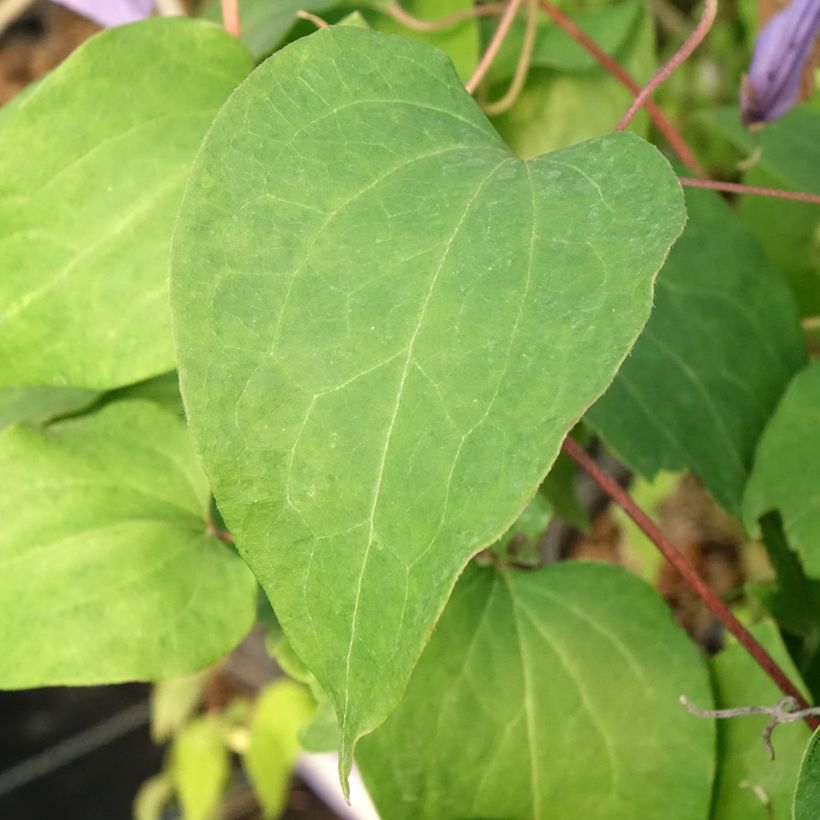

Plant habit
Flowering
Foliage
Botanical data
Clematis
x lanuginosa
Lawsoniana
Ranunculaceae
Cultivar or hybrid
Planting and care
Choose a position with morning sun, partial shade, or even north-facing to plant the Lawsoniana clematis. Shade the base of your clematis with a ground cover plant, a perennial geranium, or even a tile, a log, or any material that will keep the base of the plant in shade without obstructing air circulation. Clematises like to have cool feet. Position your plant by covering the root ball with 3 cm (1.2 in) of soil, in soil worked to a depth of 20 cm (7.9 in), lightened with good compost. In the first few weeks, water abundantly and regularly. Clematises cling to supports thanks to their tendrils. To promote their growth, provide them with a trellis or let them dress the trunk of a tree by placing a wire mesh. Clematises also like to grow freely on neighbouring plants. You can prune it in April up to a height of 100 cm (39.4 in). We advise against overwatering, as stagnant water can cause fungus at the base.
Planting period
Intended location
Care
Planting & care advice
-
, onOrder confirmed
Reply from on Promesse de fleurs
Similar products
Haven't found what you were looking for?
Hardiness is the lowest winter temperature a plant can endure without suffering serious damage or even dying. However, hardiness is affected by location (a sheltered area, such as a patio), protection (winter cover) and soil type (hardiness is improved by well-drained soil).

Photo Sharing Terms & Conditions
In order to encourage gardeners to interact and share their experiences, Promesse de fleurs offers various media enabling content to be uploaded onto its Site - in particular via the ‘Photo sharing’ module.
The User agrees to refrain from:
- Posting any content that is illegal, prejudicial, insulting, racist, inciteful to hatred, revisionist, contrary to public decency, that infringes on privacy or on the privacy rights of third parties, in particular the publicity rights of persons and goods, intellectual property rights, or the right to privacy.
- Submitting content on behalf of a third party;
- Impersonate the identity of a third party and/or publish any personal information about a third party;
In general, the User undertakes to refrain from any unethical behaviour.
All Content (in particular text, comments, files, images, photos, videos, creative works, etc.), which may be subject to property or intellectual property rights, image or other private rights, shall remain the property of the User, subject to the limited rights granted by the terms of the licence granted by Promesse de fleurs as stated below. Users are at liberty to publish or not to publish such Content on the Site, notably via the ‘Photo Sharing’ facility, and accept that this Content shall be made public and freely accessible, notably on the Internet.
Users further acknowledge, undertake to have ,and guarantee that they hold all necessary rights and permissions to publish such material on the Site, in particular with regard to the legislation in force pertaining to any privacy, property, intellectual property, image, or contractual rights, or rights of any other nature. By publishing such Content on the Site, Users acknowledge accepting full liability as publishers of the Content within the meaning of the law, and grant Promesse de fleurs, free of charge, an inclusive, worldwide licence for the said Content for the entire duration of its publication, including all reproduction, representation, up/downloading, displaying, performing, transmission, and storage rights.
Users also grant permission for their name to be linked to the Content and accept that this link may not always be made available.
By engaging in posting material, Users consent to their Content becoming automatically accessible on the Internet, in particular on other sites and/or blogs and/or web pages of the Promesse de fleurs site, including in particular social pages and the Promesse de fleurs catalogue.
Users may secure the removal of entrusted content free of charge by issuing a simple request via our contact form.
The flowering period indicated on our website applies to countries and regions located in USDA zone 8 (France, the United Kingdom, Ireland, the Netherlands, etc.)
It will vary according to where you live:
- In zones 9 to 10 (Italy, Spain, Greece, etc.), flowering will occur about 2 to 4 weeks earlier.
- In zones 6 to 7 (Germany, Poland, Slovenia, and lower mountainous regions), flowering will be delayed by 2 to 3 weeks.
- In zone 5 (Central Europe, Scandinavia), blooming will be delayed by 3 to 5 weeks.
In temperate climates, pruning of spring-flowering shrubs (forsythia, spireas, etc.) should be done just after flowering.
Pruning of summer-flowering shrubs (Indian Lilac, Perovskia, etc.) can be done in winter or spring.
In cold regions as well as with frost-sensitive plants, avoid pruning too early when severe frosts may still occur.
The planting period indicated on our website applies to countries and regions located in USDA zone 8 (France, United Kingdom, Ireland, Netherlands).
It will vary according to where you live:
- In Mediterranean zones (Marseille, Madrid, Milan, etc.), autumn and winter are the best planting periods.
- In continental zones (Strasbourg, Munich, Vienna, etc.), delay planting by 2 to 3 weeks in spring and bring it forward by 2 to 4 weeks in autumn.
- In mountainous regions (the Alps, Pyrenees, Carpathians, etc.), it is best to plant in late spring (May-June) or late summer (August-September).
The harvesting period indicated on our website applies to countries and regions in USDA zone 8 (France, England, Ireland, the Netherlands).
In colder areas (Scandinavia, Poland, Austria...) fruit and vegetable harvests are likely to be delayed by 3-4 weeks.
In warmer areas (Italy, Spain, Greece, etc.), harvesting will probably take place earlier, depending on weather conditions.
The sowing periods indicated on our website apply to countries and regions within USDA Zone 8 (France, UK, Ireland, Netherlands).
In colder areas (Scandinavia, Poland, Austria...), delay any outdoor sowing by 3-4 weeks, or sow under glass.
In warmer climes (Italy, Spain, Greece, etc.), bring outdoor sowing forward by a few weeks.









































